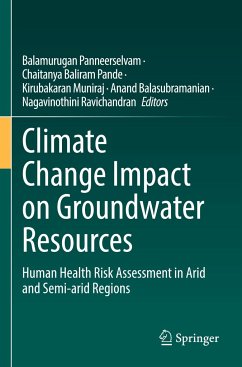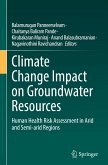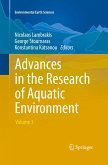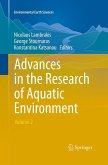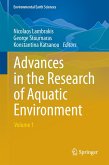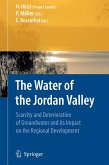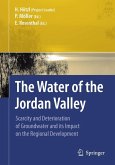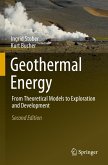Climate Change Impact on Groundwater Resources
Human Health Risk Assessment in Arid and Semi-arid Regions
Herausgegeben:Panneerselvam, Balamurugan; Pande, Chaitanya Baliram; Muniraj, Kirubakaran; Balasubramanian, Anand; Ravichandran, Nagavinothini
Climate Change Impact on Groundwater Resources
Human Health Risk Assessment in Arid and Semi-arid Regions
Herausgegeben:Panneerselvam, Balamurugan; Pande, Chaitanya Baliram; Muniraj, Kirubakaran; Balasubramanian, Anand; Ravichandran, Nagavinothini
- Broschiertes Buch
- Merkliste
- Auf die Merkliste
- Bewerten Bewerten
- Teilen
- Produkt teilen
- Produkterinnerung
- Produkterinnerung
This volume discusses climate change impacts on groundwater quality in arid and semi-arid regions, and provides human health risk assessments due to pollution of surface and groundwater. The book presents recent trends in monitoring groundwater management and implementing pollution mitigation strategies, including practices involving remote sensing and GIS techniques, entropy water quality index, weighted arithmetic water quality index, fuzzy logic applications, and improved irrigation methods. The book also outlines hydrological processes in arid and semi-arid regions and hydrochemical…mehr
Andere Kunden interessierten sich auch für
![Climate Change Impact on Groundwater Resources Climate Change Impact on Groundwater Resources]() Climate Change Impact on Groundwater Resources160,49 €
Climate Change Impact on Groundwater Resources160,49 €![Advances in the Research of Aquatic Environment Advances in the Research of Aquatic Environment]() Advances in the Research of Aquatic Environment150,99 €
Advances in the Research of Aquatic Environment150,99 €![Advances in the Research of Aquatic Environment Advances in the Research of Aquatic Environment]() Advances in the Research of Aquatic Environment149,99 €
Advances in the Research of Aquatic Environment149,99 €![Advances in the Research of Aquatic Environment Advances in the Research of Aquatic Environment]() Advances in the Research of Aquatic Environment163,99 €
Advances in the Research of Aquatic Environment163,99 €![The Water of the Jordan Valley The Water of the Jordan Valley]() The Water of the Jordan Valley112,99 €
The Water of the Jordan Valley112,99 €![The Water of the Jordan Valley The Water of the Jordan Valley]() The Water of the Jordan Valley112,99 €
The Water of the Jordan Valley112,99 €![Geothermal Energy Geothermal Energy]() Ingrid StoberGeothermal Energy82,99 €
Ingrid StoberGeothermal Energy82,99 €-
-
-
This volume discusses climate change impacts on groundwater quality in arid and semi-arid regions, and provides human health risk assessments due to pollution of surface and groundwater. The book presents recent trends in monitoring groundwater management and implementing pollution mitigation strategies, including practices involving remote sensing and GIS techniques, entropy water quality index, weighted arithmetic water quality index, fuzzy logic applications, and improved irrigation methods. The book also outlines hydrological processes in arid and semi-arid regions and hydrochemical properties of surface and groundwater as a necessary background for understanding how pollution impacts groundwater quality and resources, and how geographical modeling of hydrological processes can aid in human health risk assessments. The book is intended for academics, administrators, policymakers, social scientists, and professionals involved in the various aspectsof climate change impact on groundwater quality, hydrological process, pollution mitigation strategies, sustainable development, and environmental planning and management.
Produktdetails
- Produktdetails
- Verlag: Springer / Springer International Publishing / Springer, Berlin
- Artikelnr. des Verlages: 978-3-031-04709-1
- 1st edition 2022
- Seitenzahl: 496
- Erscheinungstermin: 26. August 2023
- Englisch
- Abmessung: 235mm x 155mm x 27mm
- Gewicht: 744g
- ISBN-13: 9783031047091
- ISBN-10: 3031047095
- Artikelnr.: 68500646
- Herstellerkennzeichnung Die Herstellerinformationen sind derzeit nicht verfügbar.
- Verlag: Springer / Springer International Publishing / Springer, Berlin
- Artikelnr. des Verlages: 978-3-031-04709-1
- 1st edition 2022
- Seitenzahl: 496
- Erscheinungstermin: 26. August 2023
- Englisch
- Abmessung: 235mm x 155mm x 27mm
- Gewicht: 744g
- ISBN-13: 9783031047091
- ISBN-10: 3031047095
- Artikelnr.: 68500646
- Herstellerkennzeichnung Die Herstellerinformationen sind derzeit nicht verfügbar.
Dr. Balamurugan Panneerselvam is a Postdoctoral researcher in the Department of Civil, Architectural and Environmental Engineering, University of Naples Federico II, via Claudio 21, 80125, Naples, Italy. His current research interests include groundwater quality assessment for drinking, irrigation and human health risk associate with major contaminants such as nitrate and fluoride in arid and semi-arid region and also related to groundwater related issues. He extended his research interest in the flied of wastewater treatment using moving bed bioreactors, performance evaluation of bioreactor in biogas unit. He received his Doctoral degree from the Anna University Chennai in 2019. His thesis was based on the groundwater quality assessment using GIS techniques in Salem district, India. He has published more than 50 papers in international and national journals. He is privileged to act as Technical Reviewer in journals in the platform of Springer, Elsevier and MDPI. With his immense interest in multidisciplinary research, his recent investigations are focused on parameter estimation using machine learning algorithms, innovative floating structures, and GIS-based potential assessment of photovoltaic systems in India. Dr. Chaitanya B. Pande completed Ph.D. in Environment Science from Sant Gadge Baba Amravati University, Amravati and M.Sc. in Geoinformatics from Amravati University in 2011. He has more than 10 years of teaching, research and industrial experience. He is a reviewer for several scientific journals of the international repute with editorial board member in Journal of American Journal of Agricultural and Biological Sciences. He has published 57 research papers, 1 textbook, 1 edited book entitled "Groundwater Resources Development and Planning in the Semi-Arid Region" in springer platform, 19 conference papers and 5 book chapters with more than 840 citations. His research interests includes Remote Sensing, GIS, Google Earth Engine, Machine Learning, Watershed management, Hydrogeology, Hydrological Modeling, Drought Monitoring, Land Use and Land Cover analysis, Groundwater Quality, urban planning, Hydro-geochemistry, Groundwater Modelling, Geology, Hyperspectral Remote Sensing, Remote Sensing and GIS application in natural resources management, watershed management and Environmental Monitoring and assessment subjects. M. Kirubakaran, basically a civil engineer and completed M.Tech in Remote Sensing at Anna University Regional Campus, Tirunelveli, TN, India and currently pursuing Ph.D under the faculty of Civil Engineering, Anna University, Chennai, TN, India in the area of Microwave Remote Sensing (InSAR). He has published more than 25 research articles in reputed international journals of Springer, Taylor and Francis, and Elsevier which includes "Environmental Research, Marine Pollution Bulletin, Environmental Geochemistry and Health, International Journal of Environmental Analytical Chemistry, Environmental Science and Pollution Research, Human and Ecological Risk Assessment, etc". Kirubakaran's research broadly focuses on Remote Sensing & GIS applications for Environmental issues, Water Resource management, Air Pollution, Solid Waste Management, Subsidence monitoring, Disaster management, Climatic Change, Urban Planning etc. He is privileged to act as Technical Reviewer in Journals including Applied Water sciences (Springer Publisher), Asia-Pacific Journal of Regional Science, Proceedings of National Academy of Sciences Part A Physical Sciences, Marine Georesources and Geotechnology etc. He is a Life Member of Indian Society of Remote Sensing, Member of International Society for Research and Development (ISRD), Associate Member of Institute of Engineers (India), and life member of Indian National Cartographic Association. Dr B. Anand M.Tech, Ph.D (KIT-Kalaignar karunanidhi Institute of Technology, Coimbatore) has completed his under graduation (B.Tech Geotechnology and Geoinformatics) in Centre for Remote Sensing, Bharathidasan University, Tiruchirappalli and M.Tech (Remote Sensing and GIS) in Regional Centre of Anna University, Tirunelveli and he completed his Ph.D in Remote Sensing and GIS with the specialization of Hydro informatics. He has worked in the NRDMS-DST Project as a JRF/SRF for three years of period. He has more than five years of research and one year of teaching experiences. He has expertise in the field of Remote Sensing, GIS and Hydro informatics with respect to Water Resources Management, Natural Resources mapping, Landslide Mapping and agricultural crop management. He has published more 10 national and international research articles in the reputed journals to his credit. He is privileged to act as Technical Reviewer in journals in the platform of Springer and Elsevier. Currently, he has working in the field of Agriculture Engineering with respect to Remote Sensing, GIS and Geoinformatics applications. Dr. Nagavinothini Ravichandran is a postdoctoral researcher in the Department of Ocean Engineering at the University of Naples Federico II, Italy. Her current research interests include computer-aided analysis of structures, earthquake engineering and structural control, floating photovoltaic systems, and machine learning applications in engineering problems. She received her Ph.D. in Ocean Engineering from the Indian Institute of Technology Madras in 2019. Her thesis is based on the dynamic analysis of offshore structures under environmental and accidental loads. She was a University first rank holder and gold medallist in her undergraduate and postgraduate studies. She has published around 50 international journals and conferences. In addition, she co-authored a textbook titled "Offshore Compliant Platforms: Analysis, Design, and Experimental Studies". She is an Associate Member of the American Society of Civil Engineers and a Life Member of the Indian Society for Technical Education. With her immense interest in multidisciplinary research, her recent investigations are focused on parameter estimation using machine learning algorithms, innovative floating structures, and GIS-based potential assessment of photovoltaic systems in India.
Chapter1. Introduction.- Chapter2. Properties of groundwater and its importance.- Chapter3. Groundwater and Health in Semi-arid and Arid Regions.- Chapter4. Groundwater Quality Status of Semi-Arid and Arid Regions.- Chapter5. Assessment of Groundwater Quality mapping for drinking purpose in semi-arid and arid regions of India.- Chapter6. Elimination of Fluoride from Drinking groundwater water Supplies.- Chapter7. Remote Sensing and GIS for groundwater geochemistry.- Chapter8. Groundwater and Artificial Recharge Planning.- Chapter9. Assessment of the appropriateness of drinking and irrigation groundwater.- Chapter10. Hydrological process in arid and semi-arid region.- Chapter11. Factors influencing hydrological process.- Chapter12. Human Health risk assessment.- Chapter13. Climate change Impact of nitrate contamination on human health.- Chapter14. Climate change Impact of fluoride contamination on human health.- Chapter15. Heavy metals influencing factors.- Chapter16. Mitigation Measures of Fluoride and Nitrate Contaminated Regions.- Chapter17. Hydrologic modelling for ungauged basins: An overview of past, present and future directions.- Chapter18.- Appraising the groundwater potential of Liddar sub-basin (western Himalayas) using geospatial techniques.- Chapter19. Groundwater Potential Zones (GPZ) delineation in Dhamani river basin in Kolhapur district, Maharashtra, India, using Remote Sensing (RS), Geographical Information System (GIS) and Multi-Criteria Decision Analysis (MCDA) techniques.- Chapter20. Assessment of groundwater potential zone mapping for development of semi-arid region through AHP and GIS techniques.- Chapter21/ Assessment of Groundwater Prospective zone in Adigrat Town and its surrounding area using Geospatial Technology.- Chapter22. Computation of rainfall infiltrates into Coastal soil of Andhra pradesh, India.- Chapter23. Feasibility assessment of low-cost filter to adopt in roof top rain water harvesting (RWH).- Chapter24. Prioritization of sub-watershed through Morphometric Analysis of Amaravathi Watershed using Geoinformatic Techniques.- Chapter25. Conclusion - Climate Change Impact on Groundwater Resources.
Chapter1. Introduction.- Chapter2. Properties of groundwater and its importance.- Chapter3. Groundwater and Health in Semi-arid and Arid Regions.- Chapter4. Groundwater Quality Status of Semi-Arid and Arid Regions.- Chapter5. Assessment of Groundwater Quality mapping for drinking purpose in semi-arid and arid regions of India.- Chapter6. Elimination of Fluoride from Drinking groundwater water Supplies.- Chapter7. Remote Sensing and GIS for groundwater geochemistry.- Chapter8. Groundwater and Artificial Recharge Planning.- Chapter9. Assessment of the appropriateness of drinking and irrigation groundwater.- Chapter10. Hydrological process in arid and semi-arid region.- Chapter11. Factors influencing hydrological process.- Chapter12. Human Health risk assessment.- Chapter13. Climate change Impact of nitrate contamination on human health.- Chapter14. Climate change Impact of fluoride contamination on human health.- Chapter15. Heavy metals influencing factors.- Chapter16. Mitigation Measures of Fluoride and Nitrate Contaminated Regions.- Chapter17. Hydrologic modelling for ungauged basins: An overview of past, present and future directions.- Chapter18.- Appraising the groundwater potential of Liddar sub-basin (western Himalayas) using geospatial techniques.- Chapter19. Groundwater Potential Zones (GPZ) delineation in Dhamani river basin in Kolhapur district, Maharashtra, India, using Remote Sensing (RS), Geographical Information System (GIS) and Multi-Criteria Decision Analysis (MCDA) techniques.- Chapter20. Assessment of groundwater potential zone mapping for development of semi-arid region through AHP and GIS techniques.- Chapter21/ Assessment of Groundwater Prospective zone in Adigrat Town and its surrounding area using Geospatial Technology.- Chapter22. Computation of rainfall infiltrates into Coastal soil of Andhra pradesh, India.- Chapter23. Feasibility assessment of low-cost filter to adopt in roof top rain water harvesting (RWH).- Chapter24. Prioritization of sub-watershed through Morphometric Analysis of Amaravathi Watershed using Geoinformatic Techniques.- Chapter25. Conclusion - Climate Change Impact on Groundwater Resources.

